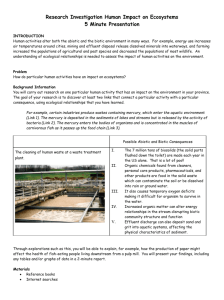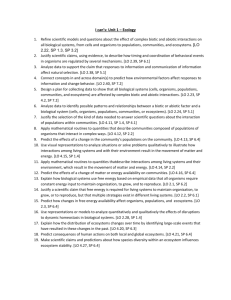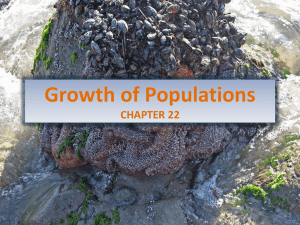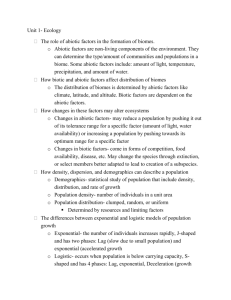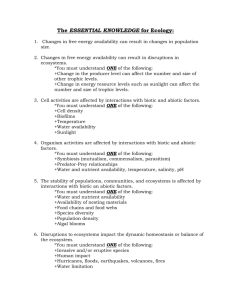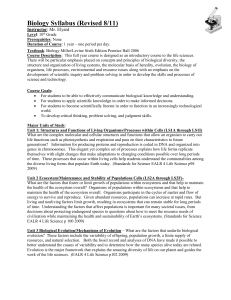Lesson 6: Exploring ecosystems - Analysing population dynamics
advertisement
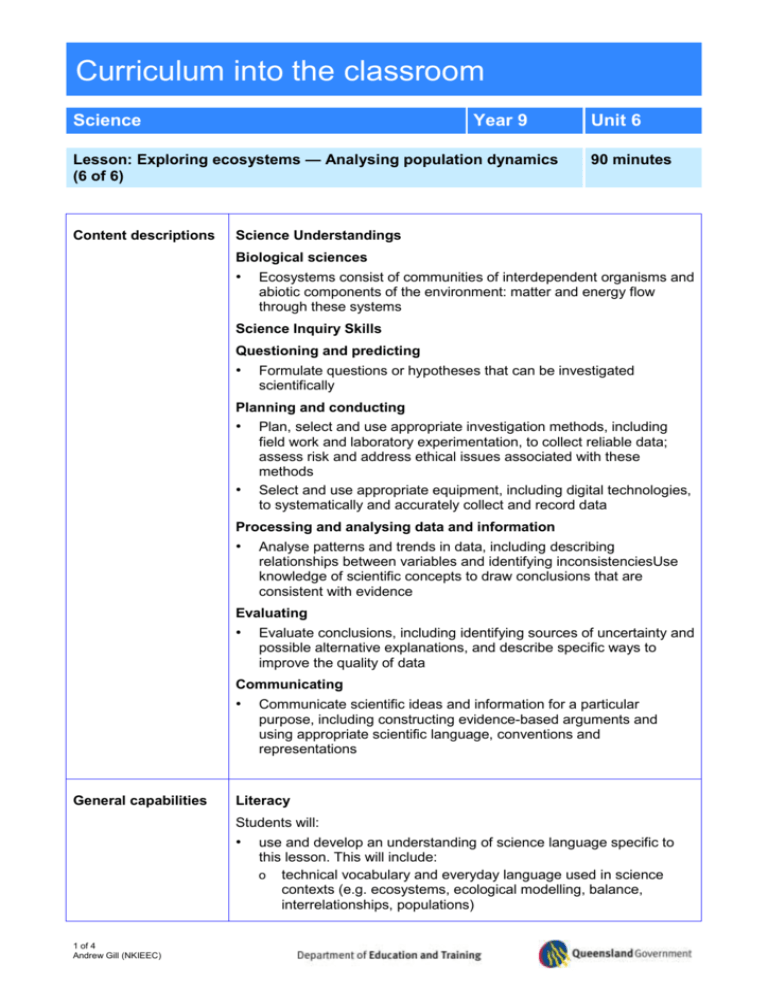
Curriculum into the classroom Science Year 9 Lesson: Exploring ecosystems — Analysing population dynamics (6 of 6) Content descriptions Unit 6 90 minutes Science Understandings Biological sciences • Ecosystems consist of communities of interdependent organisms and abiotic components of the environment: matter and energy flow through these systems Science Inquiry Skills Questioning and predicting • Formulate questions or hypotheses that can be investigated scientifically Planning and conducting • • Plan, select and use appropriate investigation methods, including field work and laboratory experimentation, to collect reliable data; assess risk and address ethical issues associated with these methods Select and use appropriate equipment, including digital technologies, to systematically and accurately collect and record data Processing and analysing data and information • Analyse patterns and trends in data, including describing relationships between variables and identifying inconsistenciesUse knowledge of scientific concepts to draw conclusions that are consistent with evidence Evaluating • Evaluate conclusions, including identifying sources of uncertainty and possible alternative explanations, and describe specific ways to improve the quality of data Communicating • General capabilities Communicate scientific ideas and information for a particular purpose, including constructing evidence-based arguments and using appropriate scientific language, conventions and representations Literacy Students will: • 1 of 4 Andrew Gill (NKIEEC) use and develop an understanding of science language specific to this lesson. This will include: o technical vocabulary and everyday language used in science contexts (e.g. ecosystems, ecological modelling, balance, interrelationships, populations) o o procedural vocabulary (e.g. hypothesise, discuss, analyse, reflect) visual representations (e.g. graphs). Numeracy Students will: • identify trends and patterns from graphs on population sizes and changes. Critical and creative thinking Students will pose questions, make predictions, and solve problems related to ecosystem dynamics and populations. Lesson objectives Students will: • understand how factors and changes influence populations. Evidence of learning Can the student: • list and describe factors that influence population sizes? • analyse data to draw conclusions regarding changes to population size? Resources Slideshow — Possum Populations Slideshow – Cyclone Yasi Learning area specific language (metalanguage) interrelationships, balance, change, populations, environmental modelling The Australian Curriculum: Science includes a glossary of definitions of language specific to the science learning area. (Select Download.) Definitions of science terms are also available from the C2C: Science glossary. Misunderstandings and alternative conceptions 2 of 4 Andrew Gill (NKIEEC) Students may demonstrate the following misunderstandings or alternative conceptions: • Students may think that population sizes are consistent over time. Explain to students that populations change and fluctuate depending on the interrelationships that exist within their ecosystem and surrounding ecosystems. Teaching and learning sequence Opening the lesson Display the slideshow Possum Populations. Teaching strategy used Consider the population change of possums on the East Coast of Australia area. Interactive teaching: Whole-class discussion Discuss with students the change in population and possible reasons for this. Focus questions: How has the possum populations within the QLD coast changed? Considering what you know of the area, what are some possible reasons for the change? Consider the population change of possums on North Keppel Island Discuss with students the change in population and reasons for this. Focus questions: How has the possum populations within NKI area changed? Considering what you know of the area, what are some possible reasons for the change? Body of lesson Show the slideshow Cyclone Yasi. Turn to work sheet and discuss questions and cyclone affect. Teaching strategies used Focus Questions: How has the ecosystem coped with the cyclone? What long term effects does the cyclone have? Are abiotic factors changeable? Indirect teaching: Inductive teaching Students to complete worksheet Cyclone Yasi identifying the effects of the cyclone and the ability of populations to recover. Closing the lesson Teaching strategy used • Interactive teaching: Whole-class discussion Review the interrelationships within populations identified in the lesson. Ask students to record the following summary, adding examples from the lesson: ‘Ecosystems are dynamic environments that continuously respond to changes in biotic and abiotic factors. The populations that reside within these systems are governed by the interrelationships that bind the ecosystem together. Changes in one abiotic factor or population will cause a shift in the population of other species due to the increase or loss of influencing factors such as predators, food, shelter and climate.’ Focus questions: What were some of the events that influenced population size? How did these events change the biotic and abiotic factors that were 3 of 4 Andrew Gill (NKIEEC) discussed earlier in the unit? How could a change of one environmental factor, biotic or abiotic, influence multiple components of a balanced system? How can humans create a change in environmental factors? 4 of 4 Andrew Gill (NKIEEC)

